Packaging Education, Plastic Bottles, Plastic Packaging
HDPE Bottles vs PET Bottles
PET and HDPE plastics are very popular for manufacturing bottles and jars. However, understanding why to use each plastic type is important to many brands and a growing consumer base. Many new points have to considered including:
- Sustainability – use less energy and raw materials
- Recyclability – will the waste fit into the current circular economy?
- Container size – can we use concentrated liquids and make the packaging smaller?
- Storage – how long will HDPE or PET last with other contents inside?
- Refill ability – can we offer refill pouches and reduce costs for both consumers & manufacturers?
These important commercial and domestic factors make packaging brands re-think their offering and solution.
We will explore why and how to compare HDPE & PET within this article.
PET Plastic Bottles
PET is also known as PETE or Polyester. PET stands for Polyethylene Terephthalate and is mainly used to manufacture plastic bottles for liquid or beverage consumption. PET is also used for many disposable plastic containers that are also used for ready-made or frozen foods. PET is popular because it provides a sound oil barrier that helps with chemicals attacking the plastic. PET can also be very clear plastic and look like glass once set to its desired shape. PET can also be colour matched to be any colour.
Temperature range
PET bottles do not have as high of a temperature resistance (less than 131°F) as HDPE. PET containers can also handle cold temperatures of about -40°F.

HDPE Plastic Bottles
High-density polyethylene (HDPE) or polyethylene high-density (PEHD) plastic is one of the most common plastics used in manufacturing; HDPE is known for its durability and strength. While not as clear as PET plastic, HDPE bottles and containers can be translucent so you can see your product inside the bottle. This type of plastic can also be colour matched and is popular in white.
Temperature Range
HDPE bottles and containers also are able to withstand colder and freezing temperatures very well (-110° F) and higher temperatures moderately well near 167°F.
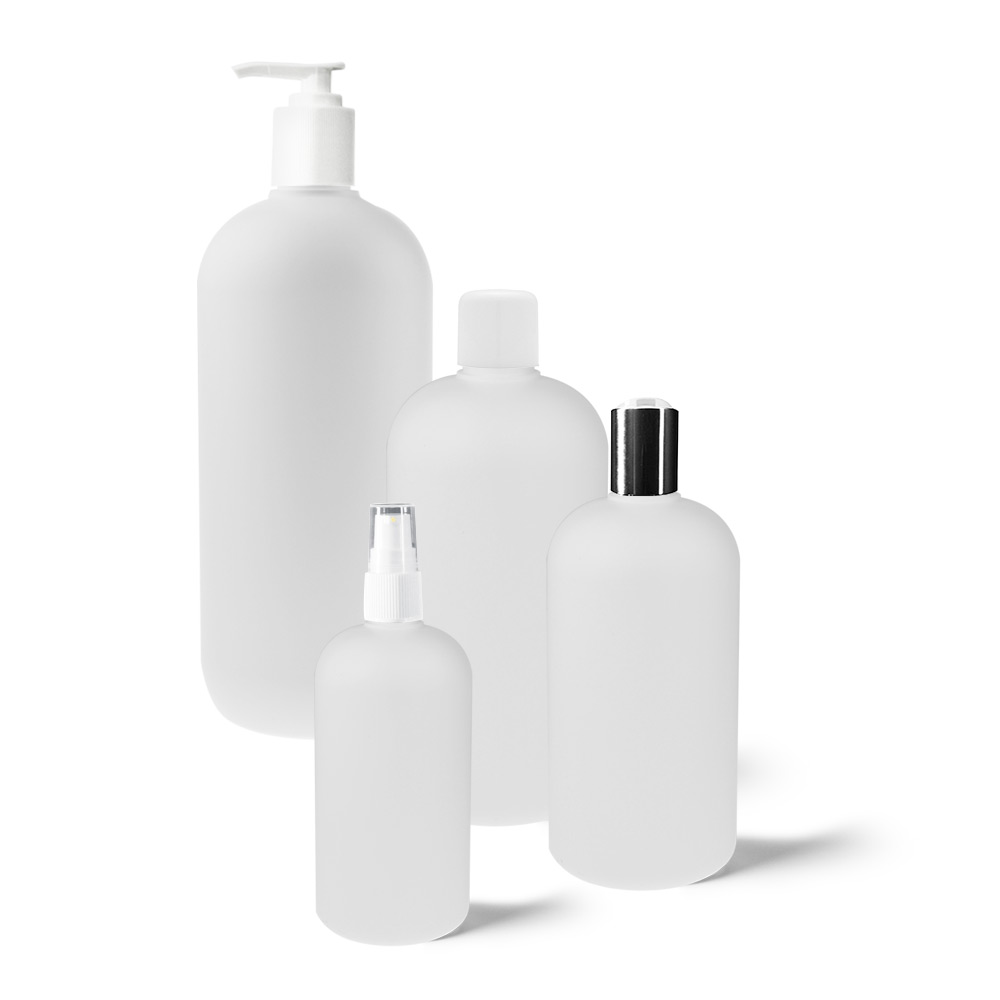
What Are The Diversities Between PET & HDPE
Understanding the diversity of different plastic types is one thing, but what are the advantages and disadvantages of each plastic type. Here is a stats table to help make up your mind.
| MATERIAL PROPERTIES | HDPE | PET |
|---|---|---|
| RIGIDITITY | 3 | 4 |
| IMPACT | 3 | 2 |
| MOISTURE BARRIER | 3 | 3 |
| GAS BARRIER | 1 | 3 |
| STRESS CRACK RESISTANCE | 2 | 5 |
| CLARITY | Semi Opaque – 2 | Clear – 5 |
| COLD RESISTANCE | -110°F – 4 | -40°F – 3 |
| HEAT RESISTANCE | 167°F – 4 | 131°F – 3 |
| METHYL ETHYL KETONE RESISTANCE | 3 | 3 |
| MINERAL OILS RESISTANCE | 4 | 3 |
| ALCOHOL RESISTANCE | 3 | 4 |
| ESSENTIAL OIL BARRIER | 2 | 3 |
| WEAK ACID RESISTANCE | 4 | 4 |
| ACETONE RESISTANCE | 3 | 1 |
| ETHYL ACETATE RESISTANCE | 3 | 3 |
| HYDROGEN PEROXIDE RESISTANCE | 5 | 3 |
| SODIUM CHLORIDE RESISTANCE | 4 | 5 |
Score Card (KEY)
Excellent = 5
Very Good = 4
Good = 3
Fair = 2
Poor = 1
| OVERALL SCORE | HDPE | PET |
|---|---|---|
| SCORE | 51 | 53 |
As you can see, there really isn’t much between each plastic type. However, you can pick a bottle that best suits your product solutions.
HDPE is a very stiff, high-density plastic with a good temperature resistance and an excellent water vapour barrier. PET plastics are highly transparent in appearance, available in different colours, lightweight and tough against gases and liquids. PET is also highly resistant to diluted acids, oils and alcohols.
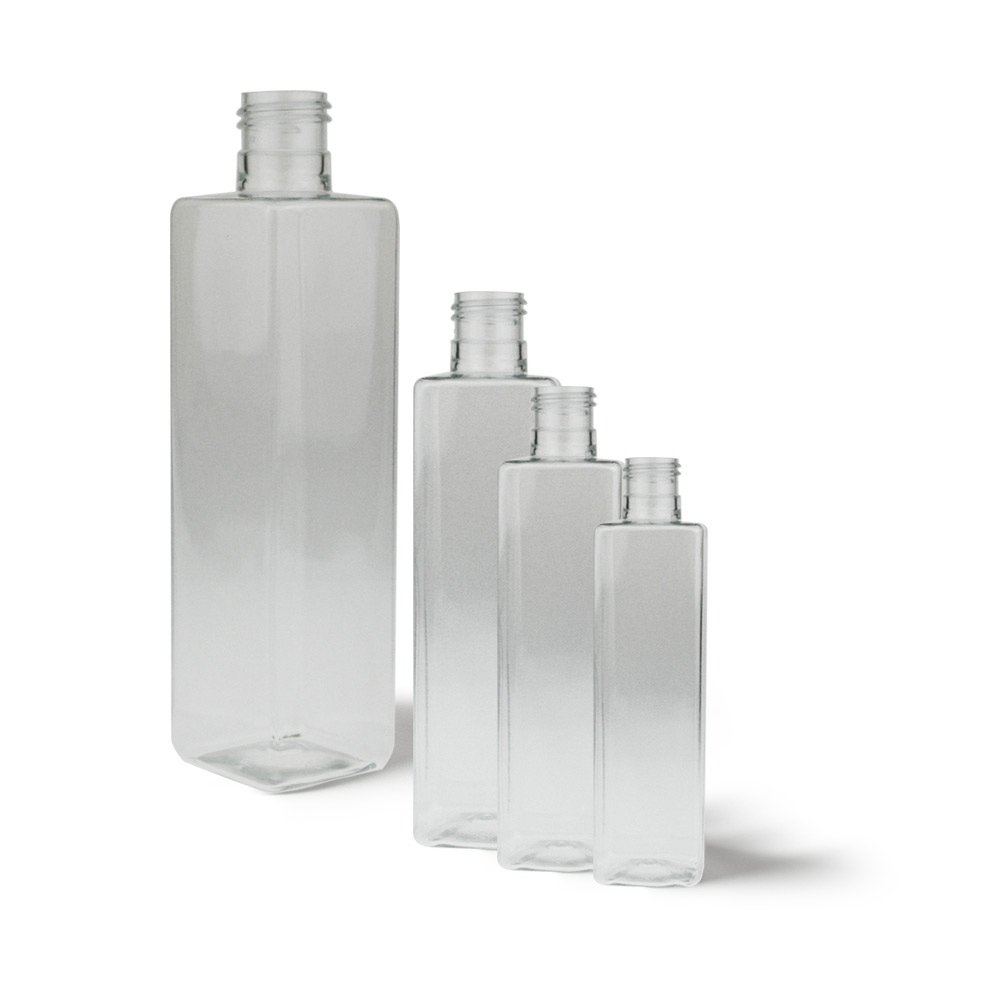
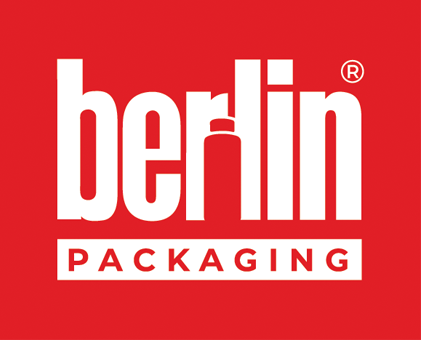
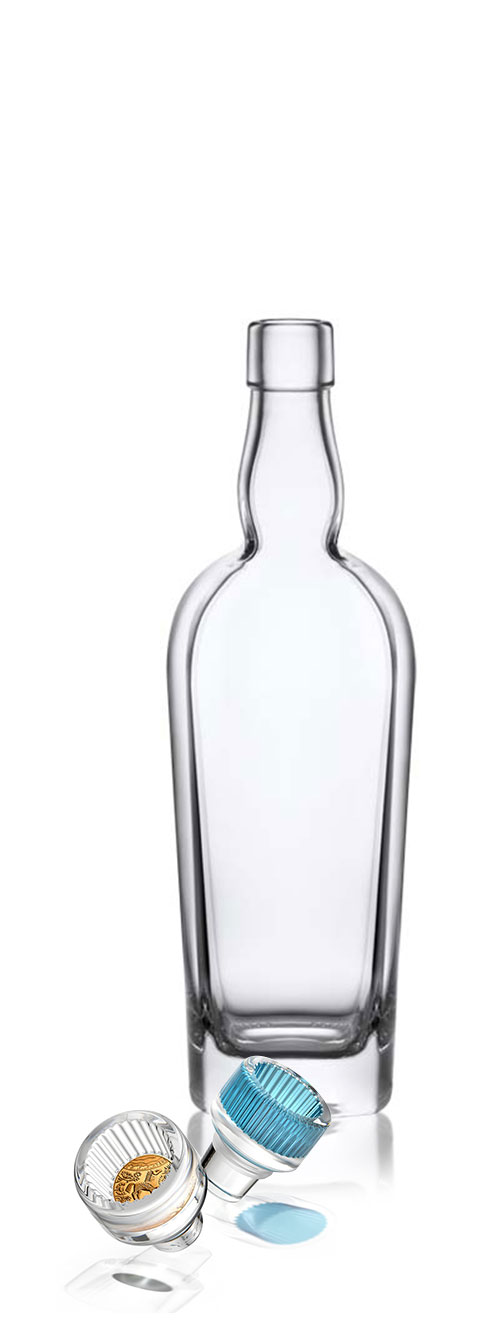
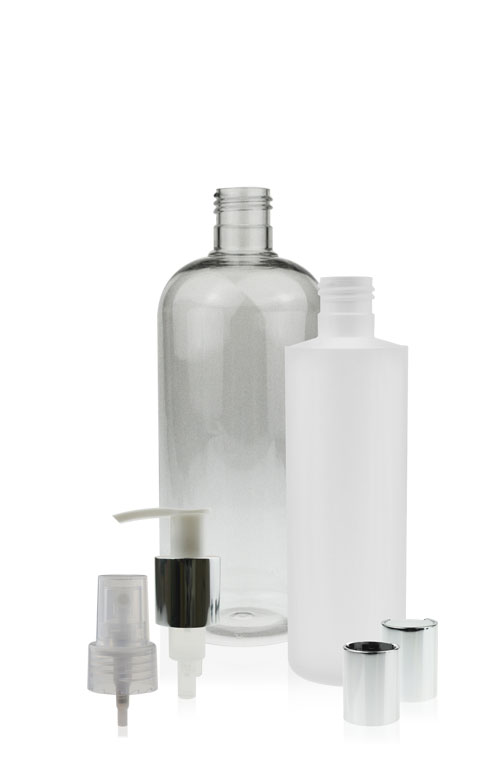


Which one is better to store witch hazel in?
Both plastic types are good for storing witch hazel oil. We would recommend testing both products. HDPE and PET bottles also come in different designs, have a range of price points and can look and feel distinctive to the touch. If you have any further queries please call one of the friendly account managers.
Hi,
I noticed all the rubbing alcohol (Isopropyl Alcohol) 70 & 90% v/v on the market is using HDPE bottle instead PET bottle. Can you tell me why the Hand Sanitizer using PET for mostly use Ethanol Base.? Is it possible use the PET bottle for rubbing alcohol.
Hello Michael,
Thanks for getting in touch. It’s to do with testing the products reaction to the plastic material container. PET or HDPE have slightly different tolerances for the chemicals being used in the product. It’s possible to use HDPE or PET but we recommend testing first.
Umesh T G,
Which one is suitable for mild surfactant packing?
Both HDPE and PET bottles are capable of storing surfactant products. However, we strongly advise testing your product. If you have further queries please get in touch.
Does PETE bottle leach any chemicals into water in it?
Hello Joyce, PETE won’t leak any chemicals into the water contained within the bottle. The only way this could be possible would be if the plastic was put under very high temperatures, to the point where the PETE bottle started to melt.
Hi there! I was wondering if HDPE is a good idea for storing hot coffee? And how it would change food safety if recycled?
Hello Paulius,
HDPE plastic bottle can store hot coffee, however, we recommend a thicker set container and a suitable cover that will go over the bottle. This can help stop hands from being burnt which is better for health and safety standards. All HDPE containers are recyclable no matter the food content. The HDPE recycling process has a ‘washing’ system that separates the HDPE plastic from any foreign bodies.
Hello Interested to why HDPE bottles are used as a preferred packaging in most if the dairy fermented beverage such as laban (pH range 4.7-4.2) etc where as in Milk PET(pH 6.5-6.8) is preferred.Is there any technical reason or just a cost factor
Hello Amit,
HDPE is great for keeping liquid products such as milk, safe, fresh and free from bacteria. The cost, recyclability factor and materials used to make HDPE is also considered for storing liquid products.
Hello, would alcohol at around 80% proof do damage to these materials…?
HDPE and PET bottles can store alcohol at this percentage just fine. However, we would complete extra tests to make sure it worked with your product.
Very good information. Thank you for putting this together.
Hey can you recommend which type of bottle is good for packing peanut butter.
Hello Shweta, Any HDPE or PET bottle could be used to store peanut butter. However, the bottle would need to be prepped for food storage. This would mean you would have to source a company with the correct certificates and the capability for sterile manufacturing.
Which one would be good to store epoxy resin, I hear it eats polycarbonate but not sure about PET. Normally epoxy resin (resin + hardener sold separately) come in HDPE but I wonder if PET would be suitable. Would you be able to comment?
Hello Barry, PET bottles should also be suitable, but we recommend testing with our manufacturing standards. If you would like further help? Please call one of the team members.
PET and HDPE, which one is more expensive?
Which one is better for lotion
Hello Paulinus,
Thanks for the question and we would love to help with an answer. PET is slightly more expensive, mainly due to the raw materials needed and consumer demand. PET has a clear, premium hard finish and is used for soaps, gels and quality products. HDPE has a larger demand, meaning the overall cost is slightly cheaper. HDPE bottles are used for lotions, shampoos, conditioners and other liquid products that allow the consumer to squeeze the bottle.
I hope this helps.
Can i store ozonated olive oil in pet bottle for long storage time
Hello Ashfaque,
Yes, you can store ozonated olive oil in pet bottles for long storage time, but we recommend you test your product to see what the effects are.
I am packaging a brine for resale and consumption that needs to be pasteurized. Which bottle is best for pasteurization?
HDPE bottles would be more suitable for pasteurized liquids. However, you will need to test your final product.
Can PET bottles be used to package a water based cleaning product with a high PH?
Hi, potentially yes, this can be used for a high PH. Is this possible to obtain the ingredients and we can advise you further? We always advise compatibility testing with all products. Thanks
Thank you for the response! What is the best way to sterilize an HDPE bottle?
Hello Jim,
It depends on what you need to sterilize it for? If it’s for a cosmetic product we would recommend washing with antibacterial tablets and wash again after. If it’s for consumption we would recommend using purification stirlazation tablets and washing after.
Can you tell me why PET bottles with a heat seal liner do not adhere to pet bottle with heat induction sealing?
Hello Susan, we found a very helpful article here
Is it safe to heat up an hdpe bottle containing emu oil? The oil tends to firm up in winter, it’s ok in other weather but because pump will not pump suggested to place in HOT water to soften. Would this cause any leaching of chemicals into the oil?
Hello Maria,
We don’t recommend heating up any soft or hard plastic bottles. This can be dangerous for the liquid contents and the rigidity of the bottle. You could place the bottle in warm water which will allow the oil the soften into a liquid state.
Which would you prefer to store Icecream?
Hello Larry,
We recommend Polypropylene (PP) for frozen food storage.
Good Day!
What are the best bottles PET or HDPE for hair oils (carrier & essential)? Better to squeeze the oil out of as well?
Thanks you in advance for your response.
Hi, PVC and CPVC solvent cements are flammable liquids…. For packaging them, PET or HDPE… Please let me know which one is better and safer….
Hello Naresh, PET and HDPE are both very robust solutions for liquid products. We recomend testing each bottle type with your product. This way you can get th best results for your brand.
Which bottles are preferred for drinking an oil based medicine and are dishwasher safe?
Hello Fred,
Unfortunately, we don’t specialise in drinking liquid food products. Our bottles are for cosmetics, soaps and toiletry products. For more information on this, I would search for companies that can supply drinking bottles. We recommend Spectra or MH plastics.
Hi, Is pet or hdpe better for Ethyl methacrylate?
Hello Tracey,
Thanks for getting in touch. Ethyl Methacrylate although organic has several side effects. Ethyl Methacrylate can affect you when breathed in. Contact can irritate the skin and eyes. Breathing Ethyl Methacrylate can irritate the nose and throat causing coughing and/or shortness of breath. High exposure to vapors can cause you to feel dizzy, lightheaded and even to pass out. We don’t use this material in our products. Maybe in the future, there could be benefits to using this material that we don’t yet understand.
Sorry, I think you might have misunderstood my question – was if I wanted to package a monomer liquid, would PET or HDPE be better?
Hi hows hdpe for beverages
Hello Hamza,
HDPE can store beverages fine. However, we recommend testing your product before going to market.
Hey I’m looking to store acrylic lacquer paints and their thinner in plastic bottles.The label for the thinner says it contains “4-methyl-2-Pentanone, 4-Hydroxy-4-methyl-2-Pentanone”. Will they damage either PET or HDPE?
Hi Timothy,
Thanks for getting in touch through our HDPE vs PET article. We recommend testing both bottles types with your product. There are several factors you need to take into consideration. Please get in touch with our Account Managers or feel free to order some samples from our website.
Hey! Nice informative content. It’s great to know that both HDPE & PET bottles are safe for packaging goods.
Can a pet plastic used for making a 20 liter to 240 liters of garbage trash cans for waste management placing it outside on the roads? The temperature here neither reaches 50°c nor -40°c?
Can such huge trash cans be made from pet plastic by blow molding method?
Hi Ashish,
We would recommend polyethylene plastic because it’s a robust plastic material that can withstand harsh elements such as acids, alkalis, fungi & bacteria.
Hi, would PET or HDPE be better for capsulated food supplements?
Many thanks
HDPE is the standard for this type of product.
Which of these plastics is more environmentally friendly? Which is more easily recycled and which takes longer to break down? Cheer in advance for any help.
Hi
Why the vegetables oil industry prefer PET rather than HDPE as a packaging material!!?
And why they don’t use PVC !!?
Thanks
Hi Dav,
Thanks for the great question. PVC and HDPE have a slight tint to the final clear container as opposed to PET having a clearer finish and looks more like glass.
Hi, Which bottle is suitable to store food products like Jaggery powder with more shelflife
Hello Jaishankar,
We would recommend our range of pouches for Jaggery Powder products. Please get in touch or talk to one of our friendly Account Managers for more information.
Hello which would you say is better for storing fresh fruit smoothies for commercial sale? HDPE or PET. with HDPE being shaded, is there an added protection from sunlight?
Hello Temi,
Thanks for getting in touch. If a plastic container is airtight, the contents will stay fresh for longer. The shaded container may add a little protection from UV rays but the contents will increase in temperature and spoil sooner. We recommend you test different HDPE & PET products while developing your ideas.
Hi
Is the PET bottles considered as Semipermeable Containers as per ICH Stability guidance when HDPE and PET bottles are having same ranking?
Hello Santhosh, thanks for stopping by and asking your question. It’s difficult to say without testing the actual liquid of a particular product. However, PET and HDPE are really good at storing some solvents and most solutes.
Hi,
Which one would be better (HDPE/PET) for Methanol solvent-based agrochemicals (Pretilachlor 50% EC). Thanks in advance.
Hi Kawsar, thanks for getting in touch through our news channel. We would recommend that you test both HDPE and PET bottles. However, both should be able to contain methanol solvent-based agrochemicals (Pretilachlor 50% EC). If you have any further enquiries? Please contact our team anytime.
Hi,
Are they both equally recyclable or is one better than the other?
Hello Mark,
Thanks for getting in touch. Both are equally recyclable and can be used in the circular economy. Plastic pellets are created and can be used in PCR (post-consumer-regrind) bottles, jars and other plastic containers.
We hope this information helps.
good day! please can you suggest any additive that can be used together with HDPE to improve its barrier properties?
Hi Harrison, thank you for getting in touch. Yes, I’m sure we can assist you further with this please contact our New Product Team on [email protected] to discuss. Thank you